Cornish firm creates kit to turn slurry emissions into fuel
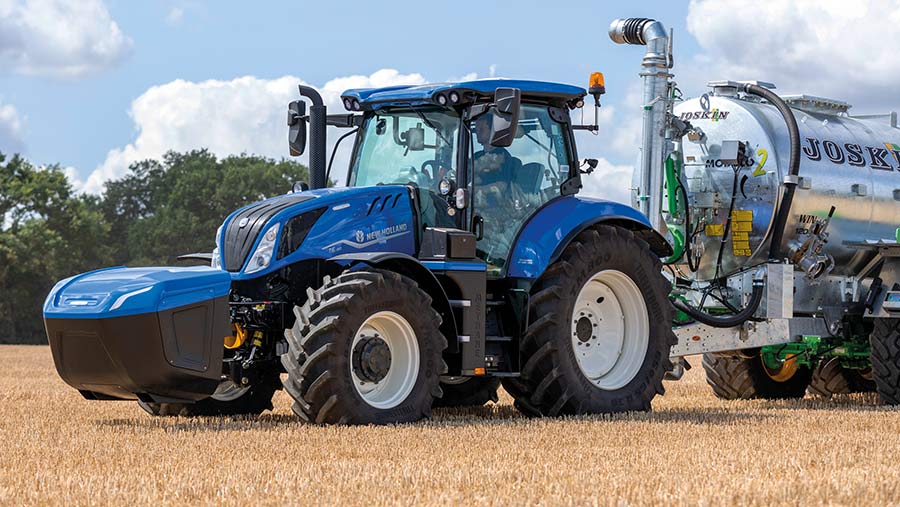 © New Holland
© New Holland Greenhouse gas emissions from livestock farming rarely make for happy reading, but a small Cornish firm has come up with a raft of clever techniques for capturing and converting them into a profitable asset.
Currently, agriculture produces about 10% of the UK’s total greenhouse gas emissions – most of which is methane – and a large chunk of this comes from manure in slurry stores and muck heaps.
Much of the current focus is on altering farming practices to reduce the amount of gas produced, but Bennamann’s approach requires little change to the way a farm operates.
“Over the next 20 years, methane has 86 times more global warming potential than carbon dioxide, but it makes a great fuel, with a far higher volumetric energy density than hydrogen,” says co-founder and chief technology officer Chris Mann.
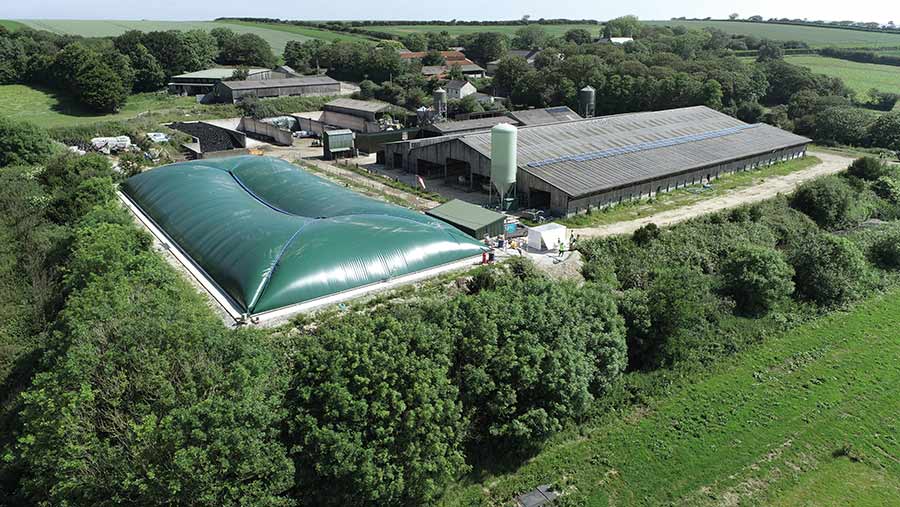
Bennamann traps methane above slurry lagoons and converts it into fuel for combustion engines © Bennamann
“By capturing it and using it to replace fossil fuels, we can quickly slow climate change and make money for us and the farm in the process.”
When methane-based fuel is burned in the latest efficient combustion engines, the only emission is a quantity of carbon dioxide equivalent to that absorbed by the organic material used to produce it.
Consequently, in its pure form, Bennamann’s regenerative cycle of converting grass to milk and slurry, capturing the methane and burning it in a combustion engine is claimed to be better than net-zero carbon.
See also: Tips and advice for planning and building a new silage clamp
About Bennamann
Bennamann was founded in 2011 by entrepreneurs and surfing buddies Michael Bennett and Chris Mann, who were keen to find local sources of clean energy that weren’t dependent on government subsidy.
They looked at various types of renewable power, before realising how much energy was simply being wasted from decomposing organic matter.
“I first became aware of this in the US, where they have to be careful storing grass clippings in garages as they can emit enough gas to blow the place up when the lights are turned on,” says Dr Mann.

Chris Mann © Bennamann
“It made me realise just how much energy is locked up in organic matter, and after that we kept spotting more opportunities.”
Initially, the plan was to use organic material such as grass clippings to make biomethane, but then they figured there was so much gas out there already that they just needed to capture it rather than produce it.
Slurry lagoons were a good place to start, as they release large amounts of gas and, once adapted, will generate power without farmers having to change the way they operate.
Dr Mann’s background in applied physics and aerospace gave him the technological background to develop the complex systems needed to run the process.
He’s now also supported by a team of 35 who are split between two sites – a design and manufacturing facility at the Aerohub adjacent to Cornwall Airport, Newquay, and a research facility at Chenoweth Farm near Truro.
The company is growing at such a rate that the workforce is planned to double in the next three years.
Fuel from slurry
Slurry lagoons are the first of the firm’s targets, and it has designed a new type of covered store that collects methane as it bubbles off the top of the liquid.
Once there is a sufficient volume of gas held above the lagoon, a processing truck is brought in to convert it into clean, compressed gas or liquid methane fuel that can be used to power combustion engines.
It’s essentially the same as compressed or liquefied biomethane (CBG and LBG), but as waste gases are being harnessed rather than intentionally breaking down organic material, they have been given a different name.
“We call it fugitive methane and the products we turn it into are compressed and liquid fugitive methane [CFM and LFM],” says Dr Mann.
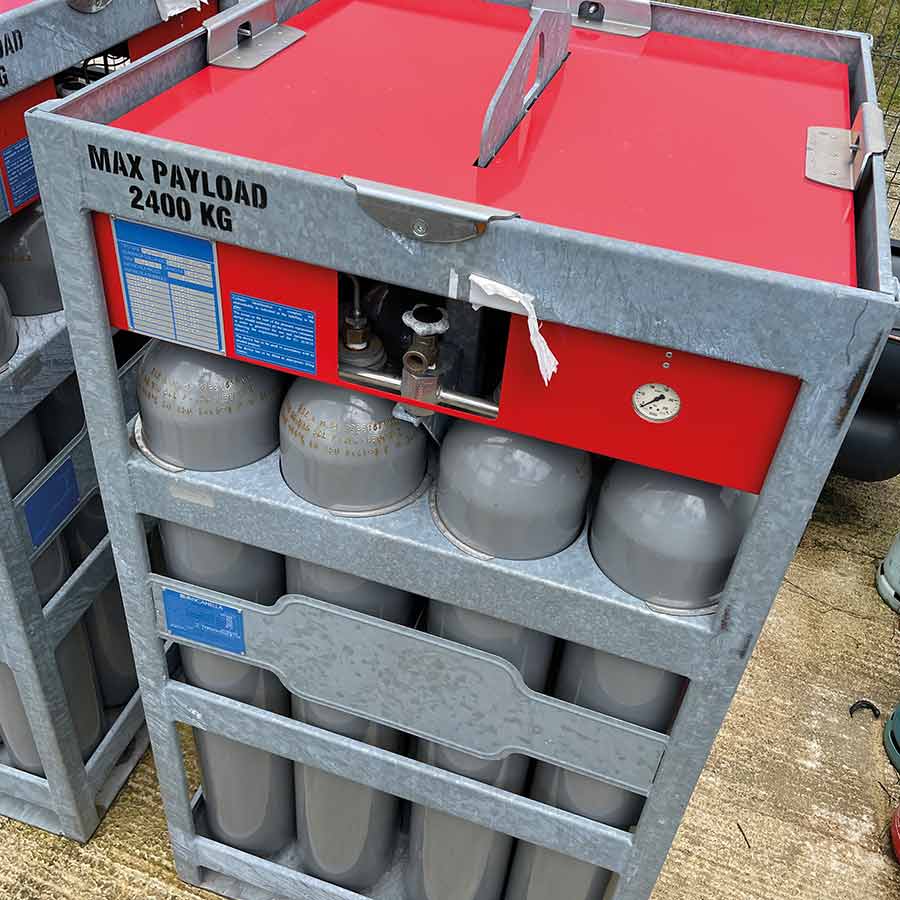
Compressed gas is stored in banks of reinforced cylinders © James Andrews
Financial benefit
As well as the environmental benefit, the value of the fuel produced should make it possible for smaller family dairy farms to justify investing in better slurry storage.
Bennamann’s lagoon costs about twice that of a conventional earth-bank construction and 30% more than an above-ground store, but the company says the value of the fuel produced means the investment should pay back in four to six years, depending on the size of the farm.
“A typical dairy farm produces six times the amount of fugitive methane that it needs to operate, so the rest can be captured, sold and we can share the profit with the farmer,” says Dr Mann.
There is also scope to run some of the farm’s vehicles on the fuel, such as new gas-powered tractors from the likes of New Holland, or existing machinery that has been fitted with a conversion kit. And it can be used for heating or powering a generator to charge electric vehicles, too.
The system has been designed so that distribution of the energy produced does not require the farm to be located near a gas main. It’s also cost-effective for farms with 50 or more cows, and there will be various financing options for farmers who want to get involved in the project.
For those who already have a good-quality store, there is a retrofit gas-capture canopy that can be placed over the top with minimal modifications.
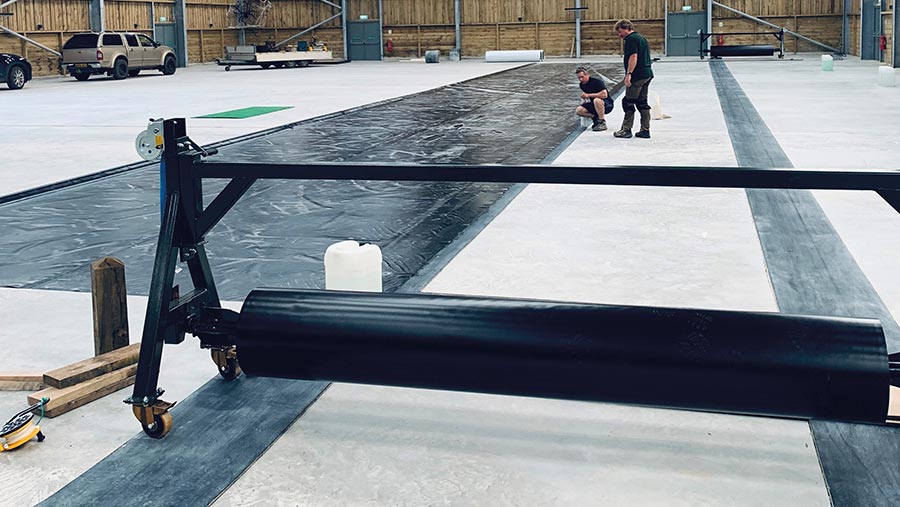
Bennamann manufacturers its innovative lagoon covers in Cornwall © Bennamann
Due to the complexity of the setup, Bennamann plans to take control of the slurry stores it installs and manage the gas-conversion process. This means the farm only has to worry about filling and emptying.
Once the gas has been harvested from the store, the slurry can be spread in the conventional manner, or it can go through an additional process to improve its soil-nourishing properties. This involves killing off anaerobic bacteria with air before introducing aerobic bacteria from compost or manure, the effects of which are currently being trialled.
Trial farms
Bennamann’s development work – part-funded by the European Regional Development Fund – has been carried out on Chenoweth Farm near Truro, which is run by the Foote family.
The next phase is a two-year pilot project with Cornwall Council to collect the gas from six of its tenanted dairy farms with herd sizes ranging from 70 to 300 cows. Each farm will have a slurry lagoon with space to store a week or more’s worth of gas and this will be converted by one mobile processing unit.
The gas produced is going to be used to run a fleet of Iveco Daily road maintenance trucks operated by contractor Cormac.
These have a 3-litre gas engine that develops 136hp and 350Nm torque.
Bennamann plans to fine-tune the process over the duration of the project before rolling it out to all 58 of the council’s tenanted dairy farms.
It also has ambitious plans to serve the whole of the UK and to offer its services globally.
The firm has already attracted several investors, and CNH Industrial acquired a minority stake this year.
The clout of a major manufacturer will help Bennamann expand to a global scale and adopt a franchise model for producing gas.
Technology is in place to remotely monitor hundreds of slurry stores, but the organisation needs additional support to operate the processing vehicles and distribute the gas.
Farmers keen to get involved in the project are being encouraged to contact the company and register their interest. It will then build up a picture of demand and work out which areas are best to focus on.
One of its mobile methane conversion trucks will serve about six average-sized farms, so clusters will be required to make the economics work.
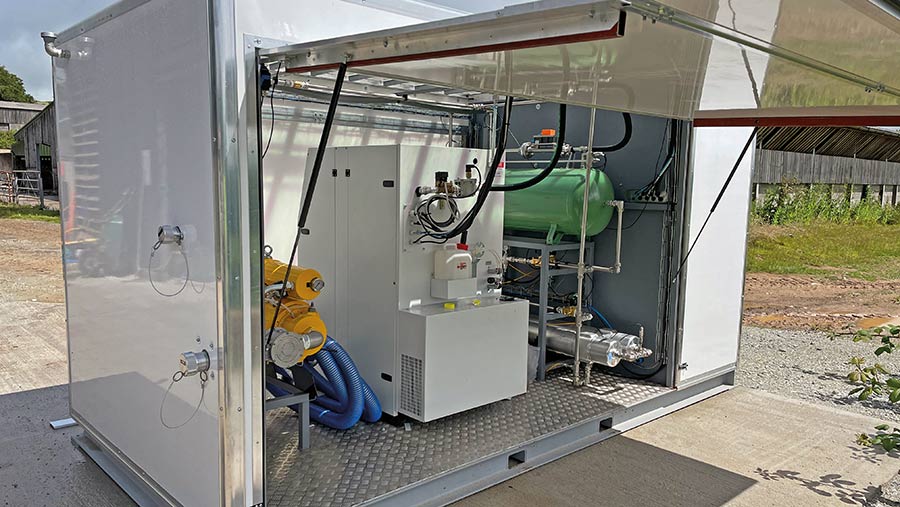
A mobile processing unit can convert lagoon methane into valuable fuel in less than 24 hours © James Andrews
Another project is a methane-powered electric vehicle charger that can be sited at remote locations without needing to draw any power from the grid.
This will have the latest FPT methane engine powering a generator and offers enough capacity to fully charge a Tesla in less than an hour.
Once these are installed, the heat generated by the engine can warm local houses, business premises or warehouses.
Compressed gas v liquid fuel
Initially, Bennamann is focusing on producing a compressed version of the gas, which is distributed in heavily reinforced bottles and tanks. This can be used to power new biomethane vehicles, such as Iveco’s range of biogas vans and trucks.
With a few minor modifications, it will also work on petrol cars fitted with LPG conversions, and kits are available to convert diesels too.
One such provider is Landi Renzo, which offers equipment for converting petrol and diesel cars to run on gas. It has also recently signed an agreement to build small gas-powered tractors for Mahindra.
For heavier machinery, the relatively low energy density of compressed methane means that large numbers of gas tanks need to be carried to get sufficient range – this is the case with New Holland’s current T6 Methane Power tractor.
Bennamann already has the technology to make the liquified version of the gas, which has six times the energy density.
This puts it into a similar ballpark as diesel, and it means heavy vehicles can use a fuel tank similar in size to that of a conventional tractor.
This technology is already being used successfully on some lorries, but the fuel needs to be managed carefully to prevent it boiling and venting emissions to the atmosphere. “As soon as these tanks start releasing, you might as well be burning fossil fuel,” says Dr Mann.
Bennamann says it has got around this problem by designing a tank with an integrated cooling device that keeps the fuel at a constant -164C. This can be powered from an external source or run off the methane in the tank.
Other farm energy sources
The firm’s engineers have also been working on a technique for capturing methane from waste feed and solid manures.
This involves adding water to the material and letting it sit for a couple of days while it forms a slurry, which can then be drawn off into a covered lagoon, where the gas can be captured. The remaining fibrous material can be spread as a soil conditioner or pasteurised and used as bedding.
They’re also looking at providing a similar fuel source from managed biodiverse herbal leys, which can be incorporated into livestock or arable enterprises.
The farm has a 1ha trial with nine carefully managed plots that they’re managing to harvest 20t of dry matter a year.
These have no artificial inputs, but they maximise the yield by monitoring the growth of each plot from space and checking the density using a plate meter.
“We’re hoping to get to the point where we can produce a quantity of methane that has the equivalent energy of one litre of petrol for every square meter of ley,” says Dr Mann.
Environmental benefits
According to Bennamann, two-thirds of the world’s methane emissions are produced by humans, and together its various forms of methane-capture technology will be able to remove one-quarter of this and use it to directly replace fossil fuels.
“This work alone would dramatically reduce the rate of global warming and give us a window for sorting out other problems,” says Dr Mann.
The firm can also store large volumes of methane above lagoons – up to several months in some cases – so there is an opportunity to burn this on demand and put additional power into the grid, without using fossil fuels.
Another key focus area is the oil and gas industry, which is responsible for 30% of the world’s methane emissions.
Together, Dr Mann and climate change consultant Tim Fox have formed the International Fugitive Emissions Abatement Association (IFEAA), which aims to raise awareness of fugitive methane and put pressure on industry to effect change.
“We now have the technology to monitor methane emissions from space and pinpoint those who are responsible for releasing it,” says Dr Mann.
Building a Bennamann slurry store
The starting point for efficient methane gas capture is Bennamann’s custom-built slurry lagoon, which is based on a standard earth bank construction.
However, the clever part is its triple-layer membrane system, which traps the gas and keeps it separate from the liquid.
The first layer is a conventional liner at the base of the pit and the second is a flexible membrane that sits on top of the liquid to prevent a crust forming.
The firm has also added a couple of jets in the pit to keep the slurry slowly moving.
As the slurry releases methane, it is captured by a perforated pipe running around the perimeter of the lagoon, just below the second membrane.
This is then piped into a pair of activated carbon filters that remove harmful toxins such as hydrogen sulphide.
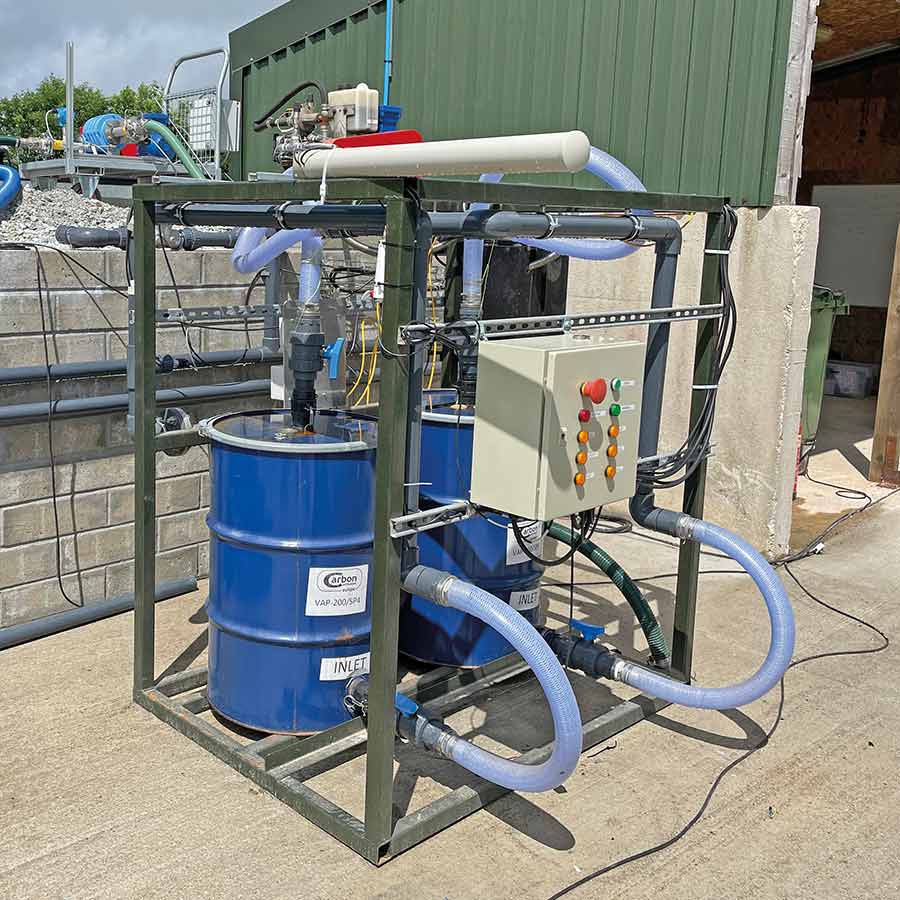
Activated carbon filters remove nasties such as hydrogen sulphide © James Andrews
The cleaned gas flows back onto the lagoon and is stored in a pocket between the second and third membrane. As the amount of gas increases, the third membrane expands with it, giving at least a week’s worth of storage.
The membranes are sealed into a water-filled tray around the perimeter that will alert the team to any leaks.
For good-quality existing stores, a weighted retrofit membrane can be installed with minimal modifications. This isn’t quite as well sealed as the bespoke option, but it will capture most of the gas released.
All lagoons are fitted with an array of smart sensors that monitor parameters such as gas quantity, quality and temperature.
These allow the lagoons to be constantly monitored without having to keep an operator on the farm.
Bennamann manufactures the membranes in-house, and is currently building a larger, custom production facility at Chenoweth Farm.

